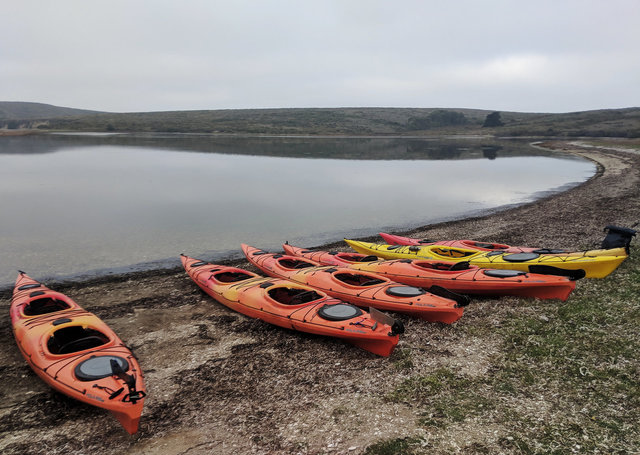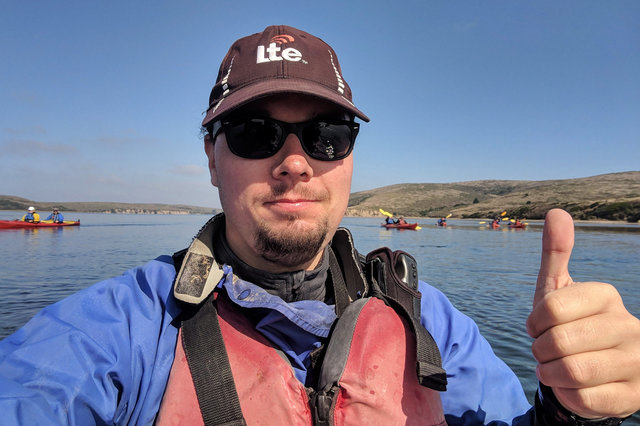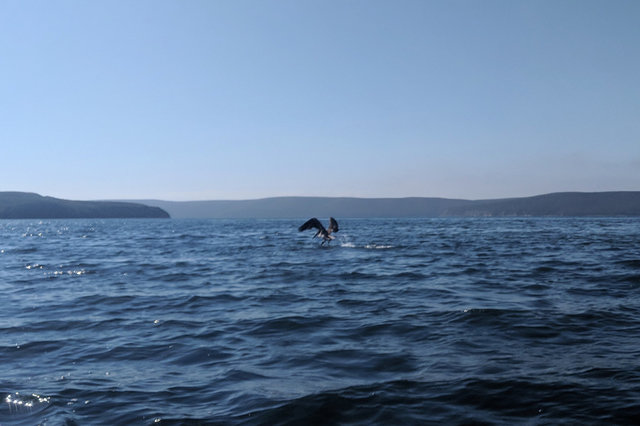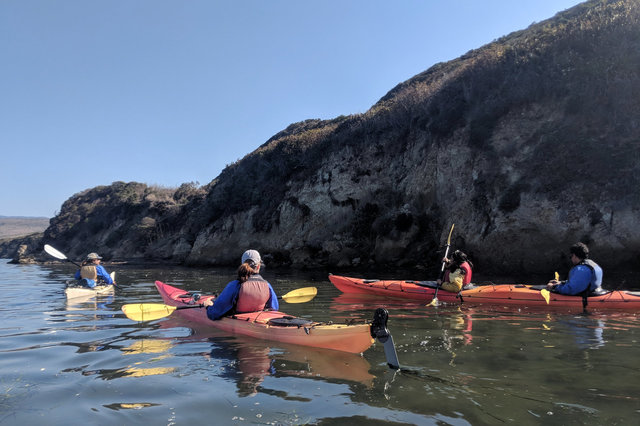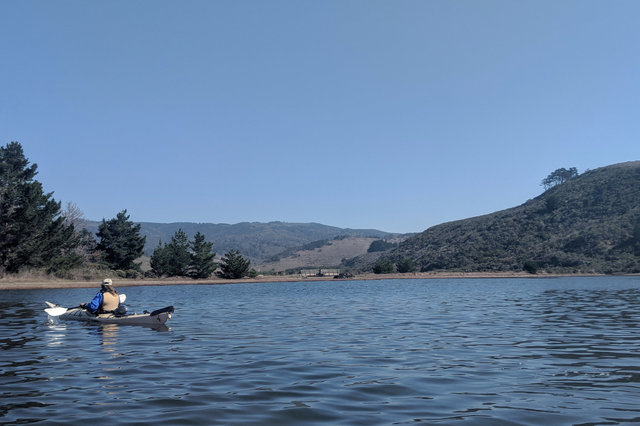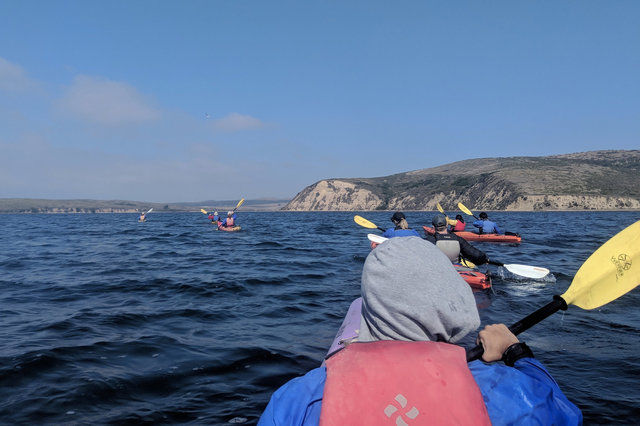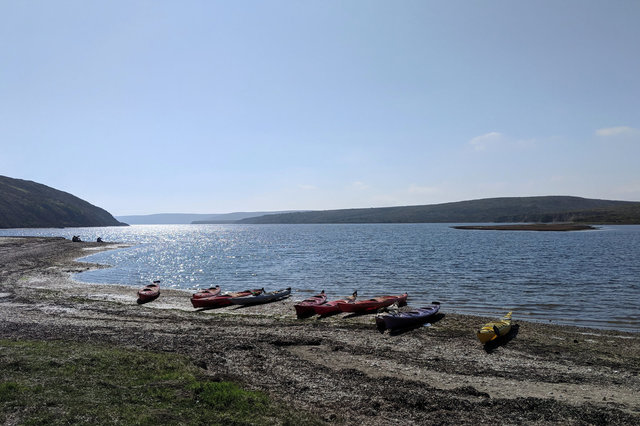Drakes Estero
Started: 2018-10-28 15:15:34
Submitted: 2018-10-28 22:56:56
Visibility: World-readable
20 October 2018: In which the intrepid narrator returns to Point Reyes to kayak in Drakes Estero
One of the things at the top of my todo list before moving away from San Francisco was to kayak in Drakes Estero, a giant enclosed saltwater bay in the middle of Point Reyes National Seashore. The bay was closed for harbor seal pupping for half of the year, and when the bay reopened the tide and winds conspired to keep me out of the water. (I spent a weekend at Point Reyes at the beginning of July and ended up hiking along the estero instead, and did at least manage to kayak on Tomales Bay.)
Then I took the opportunity to return to San Francisco for a weekend to climb Salesforce Tower, and signed up for a kayak tour on Drakes Estero on Saturday before the climb.
On Saturday morning, 20th October, I drove across Marin County to Point Reyes National Seashore and parked at the former site of the Drakes Bay Oyster Company, on the northern arm of Drakes Estero. I met my guides from outfitter Blue Waters Kayaking, led by Jangee (it was German, he said, so he pronounced it like "yan-ji", and I'm reverse-engineering the spelling) and Scott. They had lined up the kayaks on the beach, under gray skies. The beach was composed mostly of fragments of oyster shells from decades of oyster farming in the bay, but all of the oyster farm's buildings and oyster beds had been removed, leaving behind a small flat area next to the parking lot covered by scraggly grass.
The tour group assembled -- mostly couples, plus a group of five South Asians and me. I ended up at the back of a double touring kayak with the one of the South Asians, who turned out to have worked for Qualcomm in San Diego. (I pointed out that I was wearing the LTE hat I got while I worked at Qualcomm.)
After our briefing, orientation, and kayak fitting, we launched into the calm waters of Schooner Bay, the largest arm of Drakes Estero, reaching the furthest north. The water was flat and glassy under calm winds; the clouds had lifted but a haze clung to the rolling hills surrounding the saltwater inlet. A solitary black dairy cow stood on the hillside overlooking the water. The experience of paddling on the water was sublime.
The water was teeming with wildlife. Shortly after we launched I saw a harbor seal, its black head sticking up from the water looking like a graceful dog. There were cormorants everywhere, sometimes spreading their wings to dry them after diving for fish. On the shore under the cliffs lining the bay I saw several herons, and in the middle of the bay brown pelicans dove for fish; it looked like they had barely stuck their beaks under water before they surfaced again.
We paddled south through Schooner Bay, between low sandstone cliffs and rolling grassy hills, over a forest of eel grass growing from the bottom of the bay. Our guide pointed out the distant roar of the ocean breakers miles away on the miles-long Great Beach. To the south, fading away into the haze, I tried to make out the mouth of the estero where it joins the ocean.
We turned eastward into Home Bay and paddled below the bluffs where I hiked in July. The tide was high so we could investigate the intertidal mud flats by boat, looking down through the clear water at the sea anemone living there, framed by wispy sea lettuce. I saw a four-foot leopard shark zip through the water under my boat, and one of the other guests reported seeing a raccoon's footprints in the mud -- now under the water at high tide.
We made a circuit of Home Bay, the high (but dropping) tide floating us over what would otherwise be mud flats at low tide. We paddled past the footbridge over the end of Home Bay, looking very different at high tide than the last time I saw it at low tide -- the maze of muddy channels were all inundated and invisible under the water.
We looked for bat rays in the shallow waters of Home Bay, and some people reported seeing them, but I did not.
When we reached the furthest we could paddle in Home Bay without risking running aground on the intertidal mud, we turned back towards Schooner Bay, following the north shore, past a giant flock of birds perched on a sandbar barely rising above the water appearing to guard the entrance to Home Bay. We rafted up (grabbing each other's boats to form a big, if somewhat unwieldy, raft for better stability) and our guide talked about the geology of the area -- especially that the rocks around us were on the Pacific Plate on the other side of the San Andreas Fault from the rest of North America. (This is even more visible on the other side of Point Reyes at Tomales Bay, another place Blue Water Kayaking runs tours.)
We paddled north into Schooner Bay and returned to the beach where we launched. When we were a few hundred meters from the beach I caught a quick glimpse of an otter frolicking in the water, especially its tail whipping above the water in the air as it dove into the water. There were a couple of photographers on shore taking pictures of the nearby birds with fancy telephoto lenses on their DSLRs, and when they learned of the nearby otter they ran down the beach to try to get a picture of the otter, looking like paparazzi on the shore.
We landed on the beach and disembarked, standing on solid dry land for the first time since launching hours earlier. (I did take the opportunity afforded by the raft near the end of the trip to undo my spray skirt to stretch my legs while still on the water.) While we were divesting our gear in the parking lot, separating the PFDs* from the jackets and spray skirts and paddles, our guide came up and asked if I was interested in being a kayak guide, citing the kayak classes I've taken. At Blue Water, he said, one would shadow as a guide for three trips, then join as a full-fledged guide. I said I wasn't sure that would be something that would work for me, but I did file it away for a sabbatical summer. (Later I wondered if he thought I was trained as a kayak instructor, instead of the regular intro classes I've actually taken, since he used an acronym I didn't immediately recognize.)
[* Personal flotation devices, formerly known as "life jackets". ]
I returned to my car and left the beach, happy to have had the opportunity to come back to Point Reyes and visit one of the best touring kayak destinations in California.
